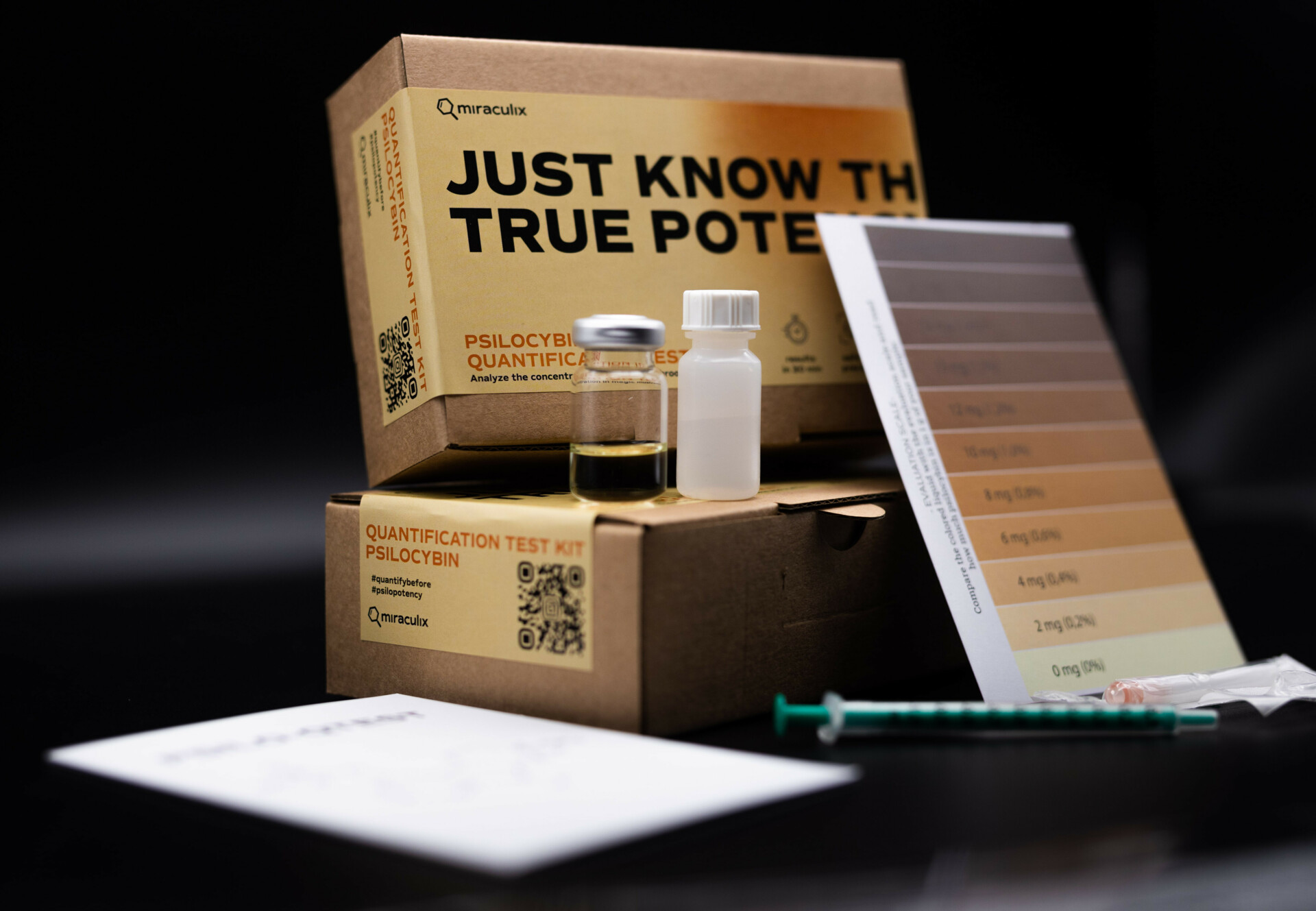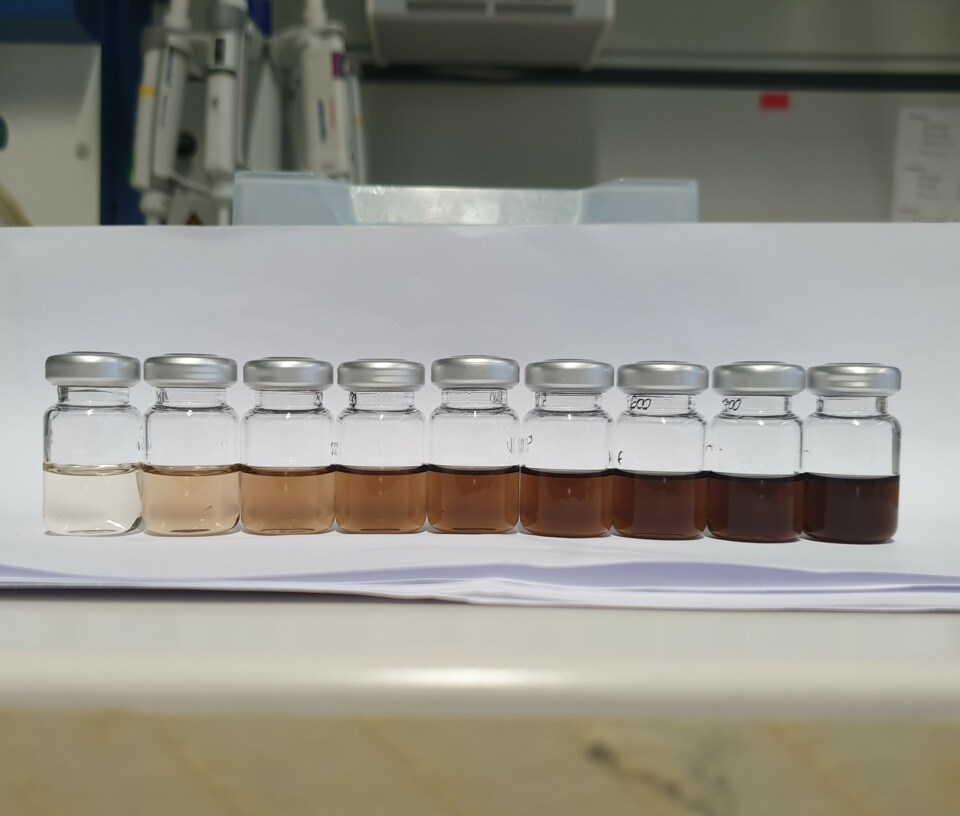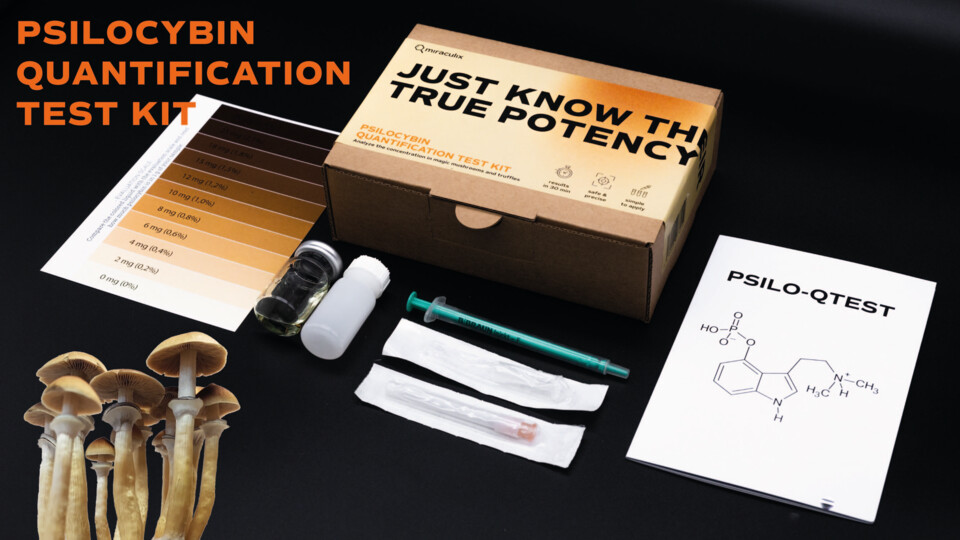
The PSILO-QTest
The active ingredient content in mushrooms can vary greatly. The differences can already occur between fruiting bodies and stems or mushrooms of the same batch.
With our Psilo-QTest, the concentration in dried fungal materials (mycelium, fruiting bodies or sclerotia "truffles") can be determined easily and precisely.
Additional information PSILO-QTest
On this page we would like to provide you with additional material and information for our PSILO-QTest, which should support you in the execution and evaluation. For example, we will provide you with comparison images for evaluation or describe how to best set up and perform the evaluation.
If there are things we have not yet listed here, but lead to questions, then you can write to us at any time.

Color series PSILO-QTest
The color row shows the individual color levels for the evaluation of the PSILO-QTest. Each color thus stands for a direct color field. This would mean that we see the following values here from left to right:
- 0% - 0.3% - 0.6% - 0.9% - 1.2% - 1.5% - 1.8% - 2.1% - 2.4%
This figure should be helpful for the evaluation if you have difficulties to estimate the correct color field. Please keep in mind that colors can look different on every screen. Thus, the images are only intended as a support and estimation.
Test execution video with all steps
In this video we will show you all the components you will receive when you get a Psilo QTest. Furthermore, we show all the individual steps to perform the quick test. For this we have used different psilocybin-containing mushrooms, so that the differences and variations in the active ingredient contents are evident. This can be seen very well especially in the evaluation step.

Frequently asked questions about the PSILO-QTest
These are the answers to frequently asked questions so far:
No. The PSILO-QTest is designed for use with dried fungal materials (e.g. mycelium, fruiting bodies, sclerotia "truffles"). Fresh mushroom material contains a very high and fluctuating water content, which would interfere with the determination by the rapid test.
In addition to the application on dried fungal material, the rapid test shows equally reliable results for most solvent-free extracts.
Extracts are usually more concentrated. To ensure that the color result of the test still fits the scale on the evaluation card, you have to reduce the amount of starting material accordingly. Before testing homogenize your substance. Typically, methanol extracts are triple-concentrated, so if you have a crude extract, we recommend dividing the amount you use for the test by the factor three (50 mg). If the extract is considerably more concentrated, reduce the initial quantity accordingly. The extract must be as solvent-free as possible, as this can interfere with the extraction solution. Remember that you have to multiply the result of the color scale in the end with the used factor to get the actual result for the remaining sample. For example, weigh 50 mg (0.05 g) of material for a 3X extract. Weigh 15 mg (0.015 g) of material for a 10X extract.
The Psilo-QTest quantifies the total alkaloid content (psilocybin + psilocin) and gives the added values in the form of a total concentration of psilocybin.
The background for this is that only the very stable active ingredient psilocybin is naturally present in healthy fungal tissue. For example, if not properly dried and stored, degradation of the prodrug psilocybin to unstable psilocin, the actual pharmacological active ingredient, occurs. Even if this occurs, the Psilo-QTest will give you information about the total amount of both alkaloids. Both substances have different molecular weights and to avoid a complicated conversion we give the value in terms of the well-known alkaloid psilocybin.
Yes we have a validation for our QTests. This is a voluntarily validated and standardized test procedure based on the pharmaceutical method validation guideline ICH Q2(R1), which we have extended to the QTests. This guideline describes the requirements of the analytical method for active ingredients that are subsequently to be used in human medicine and guarantees a safe dosage of these active ingredients, for example in pharmacies.
You can find the short report Validation here: Validation report
Yes and Yes! We would very much like to offer access to our instructions at any time. That's why we offer the possibility to view the instructions digitally and to use them for the execution. Furthermore, we would like to expand the global access and make other languages available. For this we are busy translating the individual instructions. The current instructions for our test kit can be found here:
EN (English): Psilo-QTest-Manual-English
D (German): Psilo-QTest-Manual-German
NL (Dutch:) Psilo-QTestgids-Nederlands
The tests work well with, for example, rotated or evaporated ("dry") extracts, but also some solvents like ethanol work if the concentration of alkaloids is not too low. This means that if too many foreign solvents are added to our extraction, it will disturb our extraction system.
The best way would be to evaporate the ethanol or any other solvent from a defined amount, note the dry weight, and measure it with the test.
We recommend ensuring that floating fungi are not sucked into the system and positioning the sterile filter below the floating fungus layer before applying vacuum. If the process fails initially, cleaning the filter very carefully and reapplying the syringe can help. The test can still function if fungal components are transferred, but this may complicate color evaluation. Link to the video.
Store the reagents in the refrigerator (35 - 46 °F / 2 - 8 °C) and out of direct sunlight for a shelf life of at least 18 months. The extraction liquid may turn slightly yellow over time. That’s okay. It is still usable.
You still have open questions?
We could not answer your questions completely on this page? Then write us your questions about our QTest quickly and easily in the form.